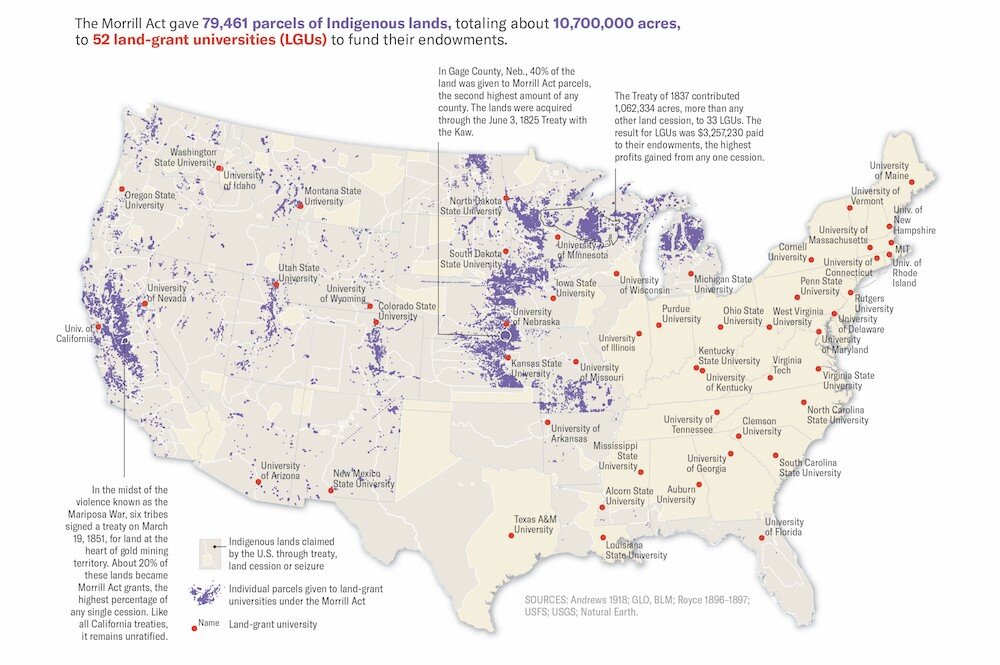'Hughes Land Is It': Land Back movement knocks at CSU's door

FORT COLLINS, Colo.—An alliance of Native and Indigenous leaders is asking for Colorado State University (CSU) to return 165 acres once home to Hughes Stadium to its original stewards.
The Hughes Land Back initiative is spearheaded by local Native and Indigenous leaders and hopes to reclaim and restore the Hughes parcel of land adjacent to Horsetooth Reservoir for their communities—and for all people.
“What could and would be nice to happen south of CSU [is] to give everyone the right to enjoy the lands that we enjoy here in Colorado,” said Kenny Frost, a citizen of the Southern Ute Indian Tribe and a private Native American consultant.
He noted that the Native American tribes that came through and shared this area did the exact same thing. They came “to camp, to provide for their Native American families and to watch their children grow and have fun. And that's the same thing that we hope to do.”
Robert Cross is a member of the Lakota Nation and wants to bring in a better understanding to the conversation of “how to develop these [lands] for Native Americans and how to continue our own ways of culture, traditions.”
“We develop [the lands] for the next seven generations,” said Christinia Eala, a member of the Lakota Nation. She thinks this community wealth-building could happen on these soils. She also has ideas on how to tackle food injustice and merge traditional and western medicine on the land.
Eala is considered a traditional elder and has lived in Colorado on-and-off since the mid-90s. When she returned to the state after a time of absence, she found that much had changed.
“I couldn't find any anywhere to live for me and the four children that I brought back with me,” she recalled. “I didn't understand why there wasn’t housing. I couldn't understand what happened to the people of color that had lived here.”
“I'm tired of seeing my elders feel like they're imposters,” said Renée Chacon. Chacon is the Youth Program Development Coordinator Vista for Spirit of the Sun, an Indigenous womxn-led nonprofit that aims to empower Native communities through youth.
“We now legitimately need restorative justice,” Chacon continued. “Restorative justice does look like providing property back, land asset development back in any form of safe spaces where we have been shut down and fleshed out of our homeland.”
Restorative justice through land is the mission of the Land Back movement in the United States. In the organization’s online manifesto, the fourth demand is to return “all public lands back into Indigenous hands.”
So, why would this movement be asking for this land back from this university? The movement asserts that many universities and colleges were not just built on stolen land but profited from the additional use and sale of stolen land provided by the Morrill Act.
The Morrill Act was signed in 1862, which gave public lands to developing institutions. The goal was to provide higher education to agricultural and industrial classes, which would modernize the economy. In fact, the act was officially titled, “An Act Donating Public Lands to the Several States and Territories which may provide Colleges for the Benefit of Agriculture and the Mechanic Arts."
High Country News investigated and located more than 99% of these lands. They found, according to their article, “approximately 10.7 million acres taken from nearly 250 tribes, bands and communities through over 160 violence-backed land cessions.”

The investigation found that Colorado State University was given 89,001 acres through the Morrill Act. The United States paid $3,654 for these acres—half of which were taken from the Arapaho and Cheyenne. This came not even a year after the Sand Creek Massacre in 1864.
According to the endowment principal raised from the granted land, CSU has raised $113—or $130 if accounting for inflation—for every dollar paid to the tribes.
In 2017, CSU said goodbye to Hughes Stadium for structural reasons. The stadium had served the institution for over 50 years. And for the past four years, the university has debated what would happen to the 165 acres of land (a full sequence of events regarding this decision can be found here).
After much campaigning by members of the public to make the Hughes area an open space, the Fort Collins City Council voted to rezone it as open lands.
But CSU clarified after the rezoning that the ordinance was not binding for the school.
In early 2021, CSU laid out a new plan for the site: it will include up to 200 affordable apartments, a transit centers, urgent care, day-care, 70 acres of open space, and more. Previously, selling the land to a private company was still on the table, but now, CSU plans to directly oversee and develop the site.

On August 6, 2021, the Hughes Land Back Alliance made their arguments during a public comment session at the CSU Board of Governors Meeting. Speakers included Kenny Frost, Christinia Eala, Renee Chacon, and Robert Cross.
In a statement provided to Rocky Mountain PBS, the CSU System highlighted their Land Acknowledgement (released in 2019) and detailed CSU’s history with the site. The statement explained that the federal government had sold the property to the school in the 1950s after it had been used as a staging area for the building of the Horsetooth Reservoir dams.
The statement reads: “Singling out Hughes as unique because of CSU’s Land Grant history is not an accurate representation of this parcel’s history. Further, the lands entrusted to the Board under its legal authority are held and managed in accordance with the Board’s fiduciary responsibility to act in the best interests of the System and its institutions and for the benefit of the citizens of the State of Colorado, and disposing of such an asset without economic benefit is inconsistent with the Board’s duties.”
But Richard Williams thinks this argument is “irrelevant.” Williams is Oglala Lakota and Northern Cheyenne and was the President and CEO of the American Indian College Fund for 15 years. Although he is officially retired, he still commits much of his time to the study of Native American history in Colorado.
Williams pointed out two important treaties in Colorado history to understand the land’s history: The Treaty of Fort Laramie and the Treaty of Fort Wise.
In 1851 the Treaty of Fort Laramie was signed between the U.S. government and several Native American nations including the Cheyenne, Arapaho, and Lakota. This treaty gave the Cheyenne and Arapaho nations sovereignty over their homelands—Platte River basin—on the condition that they allowed white migrants passage and roads and forts to be built. The government also promised to distribute $50,000 per year for 10 years to nine nations (the Arapaho, Arikara, Assiniboine, Cheyenne, Crow, Gros Ventre, Mandan, Shoshone, and Lakota nations).
With the discovery of gold in Colorado, however, this treaty was blatantly disregarded as white settlers began to illegally occupy Cheyenne and Arapaho land. This invasion depleted resources such as bison on the Great Plains. When the government failed to deliver the annuities, which the nations had begun to rely on with diminished resources, tensions increased.
By 1861 the U.S. government greatly desired to secure the gold fields and routes to and from them. With the previous treaty obsolete, another treaty was developed: the Treaty of Fort Wise.
The Treaty of Fort Wise greatly reduced the lands of the Cheyenne and Arapaho and would establish a Reservation of the Arapaho and Cheyenne where the nations would participate in an agricultural economy, abandoning their livelihoods. Despite protest from the Cheyenne Chief Black Kettle that all tribal and military leaders be present at the negotiations, the U.S. government proceeded. Further, many leaders would later disclose that they did not understand the terms presented. Williams described the affair as “deceptive.”
Most of the Cheyenne and Arapaho did not move to the determined reservation and conflict with settlers continued. This led to Colorado Territorial Governor John Evans (appointed by Abraham Lincoln) announcing that people “individually or in such parties as they may organize” should pursue Native Americans and the plains and kill or destroy them “as enemies of the country.”
On November 29th, 1864, more than 200 Cheyenne and Arapaho people were murdered by U.S. volunteer cavalry in the Sand Creek Massacre.
For Williams, this is a clear example of genocide. And Chacon thinks a form of genocide is still happening, which the Land Back movement aims to fight.
“I have to fight every day to have safe spaces for education and to hear how much my elders have been feeling like impostors. And this is their land. It's cruel…I've seen it so much in my life that I don't want my kids to have to fight as hard as I have,” said Chacon.
The Hughes Land Back movement is founded on the argument that institutions have not only greatly benefited financially from the Morrill Act, but, technically, that all the land CSU sits on was originally owned and cared for by Native and Indigenous people. The alliance also clarifies that they are only asking for 165 acres out of the thousands that CSU owns and profits from.
Chacon declared, “If you're really going to be any form of an educational institution, be a transformative one.”
More resources
- Read the full statement on the Hughes land from the Intertribal Alliance for Right Relations here.
- Between Fort Laramie and Fort Wise – A Tale of Two Treaties
- Chief Left Hand, by Margaret Coel
- Return the National Parks to the Tribes, The Atlantic
- History Colorado: Written on the Land
Clarissa Guy is a multimedia journalist at Rocky Mountain PBS. You can reach her at clarissaguy@rmpbs.org.